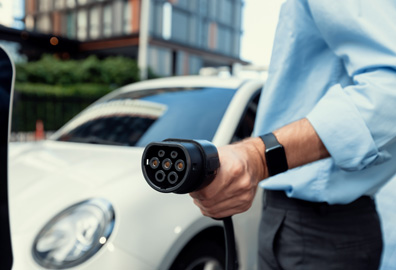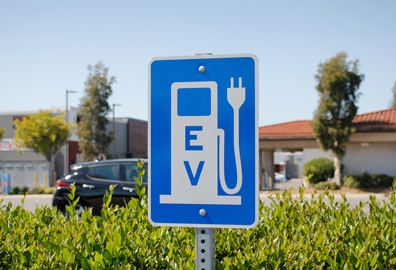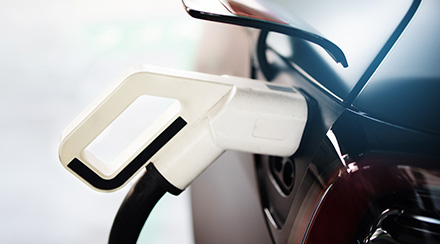How to Charge an Electric Car

Electric vehicles (EVs) are not only better for the environment, they’re easier to own in many ways. They require less routine maintenance, have fewer moving parts and allow you to “refuel” right at home.
Charging an EV is easy, but there can be a bit of a learning curve if you’re new to EVs. There are different types of chargers, different ways of paying for charging, and new places to recharge on the go.
Here’s everything you need to know:
How Long Does It Take to Charge an Electric Car?
How long your car takes to charge depends on how you’re charging it. There are three basic methods of charging an EV, which have different charging speeds and electrical requirements.
The Three Types of EV Chargers
- Level one charging – For level one charging, simply plug your EV into any grounded 120-volt outlet using the included charging cable. This is the slowest charging method and can take 50 hours or more to fully charge an empty EV battery. But at a rate of around five miles of range per hour, overnight charging can be sufficient for some in-town commutes.
- Level two charging – Level two charging uses 240-volt equipment, the same you might have powering your clothes dryer or cooktop. Level two charging at home requires installation of a charging station, but it’s the norm at most public charging stations. Level two charging adds about 25 miles of range per hour of charging, making it sufficient to fully charge most EVs overnight.
- DC fast charging – The fastest charging method is DC fast charging, which is only available at select public charging stations. It can add up to 20 miles of range per minute of charging, allowing most EV drivers to fully recharge in 20 minutes or less. While most EVs allow DC fast charging, some do not, and those that do connect in different ways.
How to Physically Connect Your EV to a Charger

If you’ve never plugged in an EV before, it can take a few minutes to get your bearings. First, you’ll need to find the vehicle’s charging port, which is located in different places on different models. It may be on either side of the vehicle, in the front or back, or even at the very front of the car. It’s usually underneath a hinged hatch that looks similar to the fuel hatch on a gas-powered car.
Next, you’ll need charging cables. These are typically included with new EVs and can be purchased as aftermarket accessories. They often consist of one main cable with multiple attachments for different types of charging ports.
To charge an electric car at home, you can simply plug in your EV with the charging cables like you would any corded appliance. First, connect the charging cable to your EV charge port with the J1772 connector. For level one charging, use a 120-volt adapter to connect the other end of the charging cable to any standard GFCI outlet. For level two charging, use a 240-volt adapter to connect the other end of the charging cable to an EV charging station.
If you need level two charging at a public charging station, look for step-by-step instructions posted at the charging bay. DC fast charging at a public charging station is a little more complicated because there are multiple connection types, and fast charging stations usually don’t accommodate them all. CSS connectors are the most common for fast charging, but some EVs use CHAdeMO connectors, and Tesla has its own proprietary connection design.
Paying for EV Charging
When you’re charging your EV at home, paying for it is simple; it just goes onto your monthly electric bill like all of your other appliances. But when you’re charging up at a public station, it gets a little more complex – though not necessarily complicated.
Most public charging stations allow (and some require) you to pay for charging using a smartphone app. These apps are free and created by EV charging networks to facilitate payments. You’ll need to create a free account and either load it with prepayment credits or link it to a credit card.
If you carry a smartphone and credit card, you can do all this in just a few minutes at the charging station. If not, you can plan ahead and set up free accounts with charging networks from your home computer. Some of these networks will send you free cards or keychain tabs that you can scan at charging stations, allowing you to charge and pay without using a smartphone.
Your EV itself may also be equipped to communicate with charging networks, allowing you to use in-car controls to authorize payments. The availability of this feature varies by manufacturer, so it’s always a good idea to explore your owner’s manual or EV manufacturer’s website for more specific tips about public charging.
Where Can I Charge My Electric Car?

EV charging stations can be as small as a single charger, which makes them harder to spot than traditional gas stations. Fortunately, there are multiple ways to find nearby charging stations when you’re on the road:
- Use your EV’s navigation system. While specific features vary by model, most EVs are equipped with a navigation system that can direct you to nearby charging stations.
- Use charging network apps. If you’re already using charging network apps to pay, you can also use them to find in-network charging stations.
- Use your EV manufacturer’s network. Each EV manufacturer has different policies for public charging at their dealerships and other proprietary locations. This may include free public charging, so it pays to know what your manufacturer offers and keep up with news about new charging locations within the manufacturer’s network.
- Plot your charging ahead of time. It helps to find a few good charging stations in strategic locations based on your commute and routine. When you’re not behind the wheel, use the Department of Energy’s interactive map of EV charging stations to find stations that work best for you.
Electric Vehicle Charging Safety Tips
Charging an EV is simple and safe, but just as with refueling gasoline-powered cars, there are a few basic safety precautions to keep in mind. Some EV models may have unique safety considerations, so it’s important to refer to your EV’s manual as your primary guide to safely charging your EV model.
The U.S. Fire Administration recommends the following general safety practices:
- Before charging at home, ensure that charging devices are professionally installed by a qualified electrician and that any new equipment is certified by a nationally recognized testing laboratory.
- For level one charging, plug into a ground fault circuit interrupter (GFCI) outlet. Do not plug into a power strip or adapter.
- Maintain your charging equipment to manufacturer specifications and do not use any equipment if it shows obvious signs of damage or wear.
- Keep your EV charging port covered when not in use to prevent moisture from entering.
- Keep all charging components out of reach of children.
Looking for Something Specific?
Select a category to find resources for topics that interest you.
Select Category

Related Articles:

Are Electric Cars Better for the Environment?
Electric cars produce virtually zero emissions while they’re being driven, but charging car batteries and the materials used to make these batteries have their own environmental impact. See how these effects balance out.
Read Article
Are Electric Cars Worth It?
Electric cars are becoming more popular among consumers and car makers for their impressive technology and positive environmental impact. When deciding whether an electric car is right for you, consider these benefits as well as the trade-offs.
Read Article
Are Electric Cars Cheaper in the Long Run?
The popularity of electric cars is growing as manufacturers introduce affordable models that can drive farther on a single charge. While great for the environment, are they great for your wallet?
Read ArticleMost Popular Articles

Electric Vehicle Guide
Whether you're deciding if an EV is right for you or setting up a home charger, our Electric Vehicle Guide can help you wherever you are in your EV journey. Learn More.
How to Charge an Electric Car
Electric vehicles (EVs) are not only better for the environment, they’re easier to own in many ways. They require less routine maintenance, have fewer moving parts and allow you to “refuel” right at home.
Charging an EV is easy, but there can be a bit of a learning curve if you’re new to EVs. There are different types of chargers, different ways of paying for charging, and new places to recharge on the go.
Here’s everything you need to know:
How Long Does It Take to Charge an Electric Car?
How long your car takes to charge depends on how you’re charging it. There are three basic methods of charging an EV, which have different charging speeds and electrical requirements.
The Three Types of EV Chargers
- Level one charging – For level one charging, simply plug your EV into any grounded 120-volt outlet using the included charging cable. This is the slowest charging method and can take 50 hours or more to fully charge an empty EV battery. But at a rate of around five miles of range per hour, overnight charging can be sufficient for some in-town commutes.
- Level two charging – Level two charging uses 240-volt equipment, the same you might have powering your clothes dryer or cooktop. Level two charging at home requires installation of a charging station, but it’s the norm at most public charging stations. Level two charging adds about 25 miles of range per hour of charging, making it sufficient to fully charge most EVs overnight.
- DC fast charging – The fastest charging method is DC fast charging, which is only available at select public charging stations. It can add up to 20 miles of range per minute of charging, allowing most EV drivers to fully recharge in 20 minutes or less. While most EVs allow DC fast charging, some do not, and those that do connect in different ways.
How to Physically Connect Your EV to a Charger
If you’ve never plugged in an EV before, it can take a few minutes to get your bearings. First, you’ll need to find the vehicle’s charging port, which is located in different places on different models. It may be on either side of the vehicle, in the front or back, or even at the very front of the car. It’s usually underneath a hinged hatch that looks similar to the fuel hatch on a gas-powered car.
Next, you’ll need charging cables. These are typically included with new EVs and can be purchased as aftermarket accessories. They often consist of one main cable with multiple attachments for different types of charging ports.
To charge an electric car at home, you can simply plug in your EV with the charging cables like you would any corded appliance. First, connect the charging cable to your EV charge port with the J1772 connector. For level one charging, use a 120-volt adapter to connect the other end of the charging cable to any standard GFCI outlet. For level two charging, use a 240-volt adapter to connect the other end of the charging cable to an EV charging station.
If you need level two charging at a public charging station, look for step-by-step instructions posted at the charging bay. DC fast charging at a public charging station is a little more complicated because there are multiple connection types, and fast charging stations usually don’t accommodate them all. CSS connectors are the most common for fast charging, but some EVs use CHAdeMO connectors, and Tesla has its own proprietary connection design.
Paying for EV Charging
When you’re charging your EV at home, paying for it is simple; it just goes onto your monthly electric bill like all of your other appliances. But when you’re charging up at a public station, it gets a little more complex – though not necessarily complicated.
Most public charging stations allow (and some require) you to pay for charging using a smartphone app. These apps are free and created by EV charging networks to facilitate payments. You’ll need to create a free account and either load it with prepayment credits or link it to a credit card.
If you carry a smartphone and credit card, you can do all this in just a few minutes at the charging station. If not, you can plan ahead and set up free accounts with charging networks from your home computer. Some of these networks will send you free cards or keychain tabs that you can scan at charging stations, allowing you to charge and pay without using a smartphone.
Your EV itself may also be equipped to communicate with charging networks, allowing you to use in-car controls to authorize payments. The availability of this feature varies by manufacturer, so it’s always a good idea to explore your owner’s manual or EV manufacturer’s website for more specific tips about public charging.
Where Can I Charge My Electric Car?
EV charging stations can be as small as a single charger, which makes them harder to spot than traditional gas stations. Fortunately, there are multiple ways to find nearby charging stations when you’re on the road:
- Use your EV’s navigation system. While specific features vary by model, most EVs are equipped with a navigation system that can direct you to nearby charging stations.
- Use charging network apps. If you’re already using charging network apps to pay, you can also use them to find in-network charging stations.
- Use your EV manufacturer’s network. Each EV manufacturer has different policies for public charging at their dealerships and other proprietary locations. This may include free public charging, so it pays to know what your manufacturer offers and keep up with news about new charging locations within the manufacturer’s network.
- Plot your charging ahead of time. It helps to find a few good charging stations in strategic locations based on your commute and routine. When you’re not behind the wheel, use the Department of Energy’s interactive map of EV charging stations to find stations that work best for you.
Electric Vehicle Charging Safety Tips
Charging an EV is simple and safe, but just as with refueling gasoline-powered cars, there are a few basic safety precautions to keep in mind. Some EV models may have unique safety considerations, so it’s important to refer to your EV’s manual as your primary guide to safely charging your EV model.
The U.S. Fire Administration recommends the following general safety practices:
- Before charging at home, ensure that charging devices are professionally installed by a qualified electrician and that any new equipment is certified by a nationally recognized testing laboratory.
- For level one charging, plug into a ground fault circuit interrupter (GFCI) outlet. Do not plug into a power strip or adapter.
- Maintain your charging equipment to manufacturer specifications and do not use any equipment if it shows obvious signs of damage or wear.
- Keep your EV charging port covered when not in use to prevent moisture from entering.
- Keep all charging components out of reach of children.
Looking for Something Specific?
Select a category to find resources for topics that interest you.
Select Category

Related Articles:

Are Electric Cars Better for the Environment?
Electric cars produce virtually zero emissions while they’re being driven, but charging car batteries and the materials used to make these batteries have their own environmental impact. See how these effects balance out.
Read Article
Are Electric Cars Worth It?
Electric cars are becoming more popular among consumers and car makers for their impressive technology and positive environmental impact. When deciding whether an electric car is right for you, consider these benefits as well as the trade-offs.
Read Article
Are Electric Cars Cheaper in the Long Run?
The popularity of electric cars is growing as manufacturers introduce affordable models that can drive farther on a single charge. While great for the environment, are they great for your wallet?
Read ArticleMost Popular Articles

Electric Vehicle Guide
Whether you're deciding if an EV is right for you or setting up a home charger, our Electric Vehicle Guide can help you wherever you are in your EV journey. Learn More.







